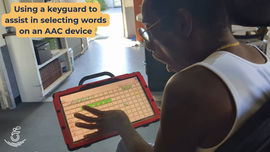What is AAC?
Augmentative and Alternative Communication

AAC stands for "augmentative and alternative communication". The American Speech and Hearing Association (ASHA) describes AAC simply as “all the ways that someone communicates besides talking” www.asha.org. If someone has a communication disorder that impacts their ability to speak, they may use technology to produce the messages that they want to communicate. AAC also includes other ways we communicate such as using sign language, gestures, facial expressions, or pointing to pictures.
AAC
Even people who don’t have a communication disorder use forms of AAC such as facial expression, gestures, and body language to help get messages across. In these cases, we are augmenting our verbal communication by using a gesture to better communicate our message. Feel free to caption these pictures of an unofficial Communication Horizons team member with how her facial expressions are augmenting her message.

There are high-tech, low-tech, and no-tech ways to communicate
"No-tech" or "low-tech" AAC methods include sign language, pointing to or exchanging pictures of words we want to communicate, writing out a message, or pressing a button that has a prerecorded message.
"High-tech" AAC includes applications and software on an iPad or other durable tablet that offer hundreds or thousands of pre-stored words, and can be fully customized to allow for someone to communicate anything.
.png)
.png)
.png)
No physical disability is too complex for AAC.
There are many different ways that a person can access a high-tech communication device. We are committed to finding a way to help our clients access technology for both communication and controlling essential things in their environment. Using a finger to touch a screen is FAR from the only way to control an AAC device.
When fine and gross motor challenges impact one’s ability to reach out and touch a screen, a high-tech AAC device can be accessed / controlled in a number of ways, including:
-
Using a hand with assistance from a keyguard
-
Eye tracking camera
-
Head tracking / head mouse
-
Switches
-
Joystick
Our team of SLP and PT work together to find the most optimal way to access an AAC device.





